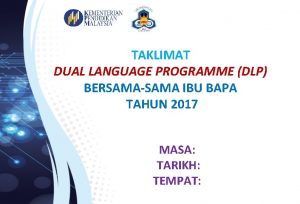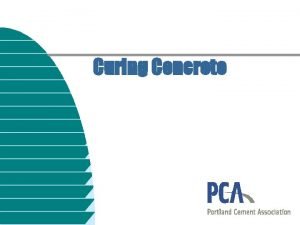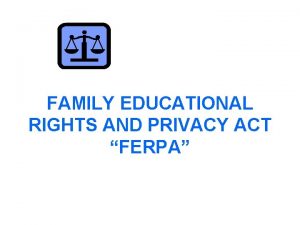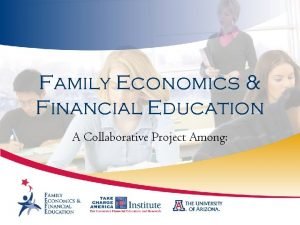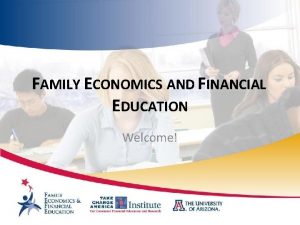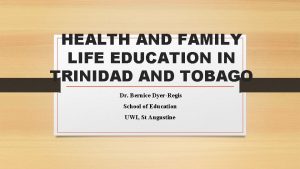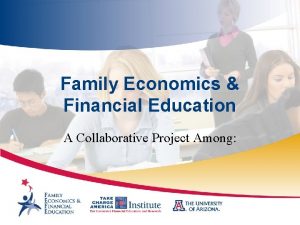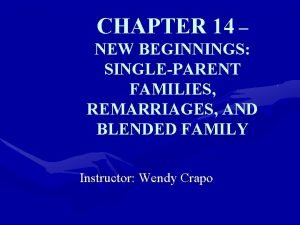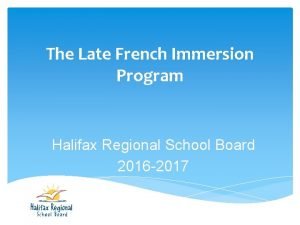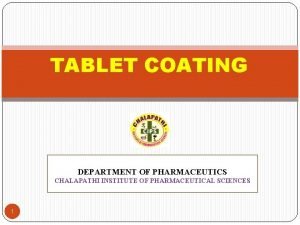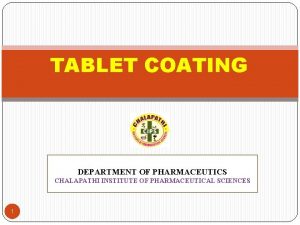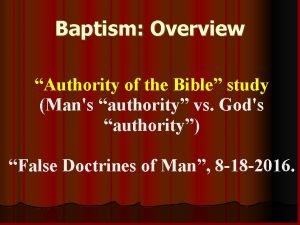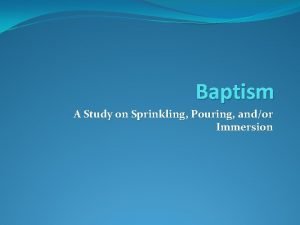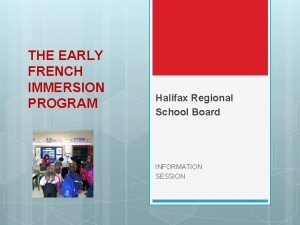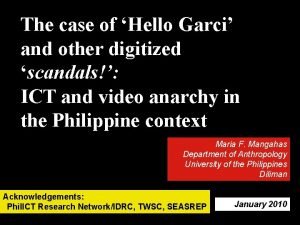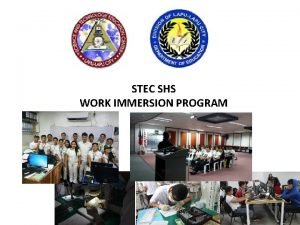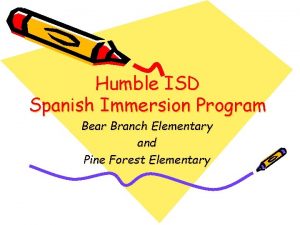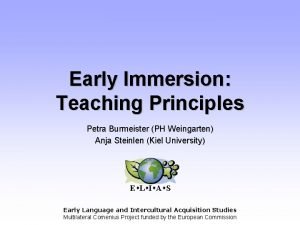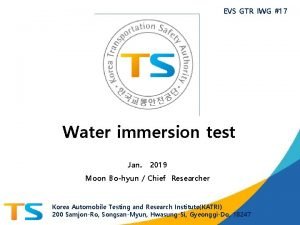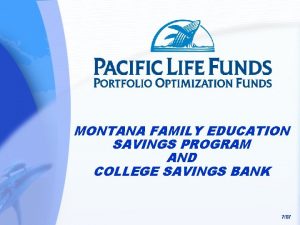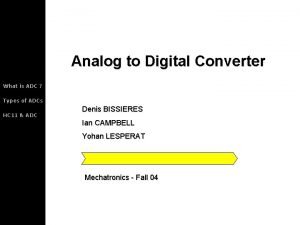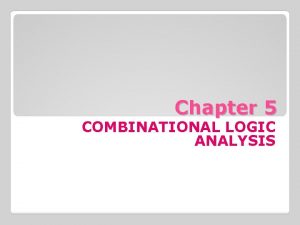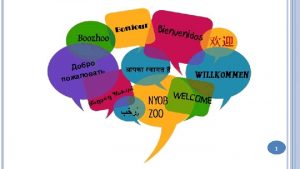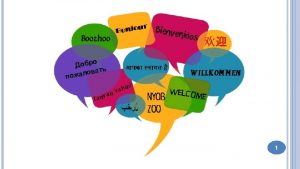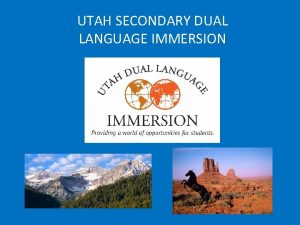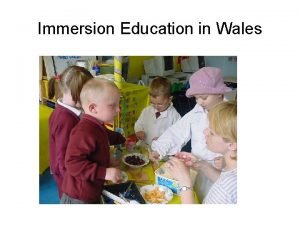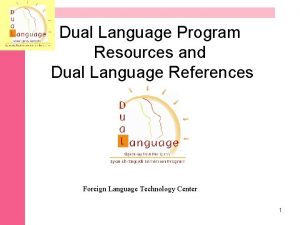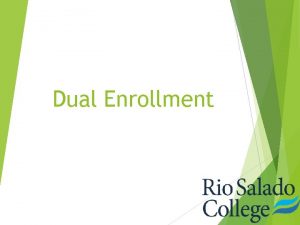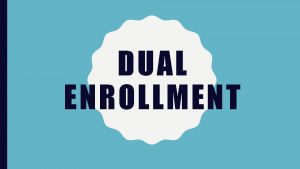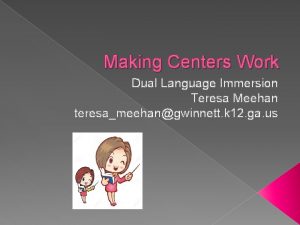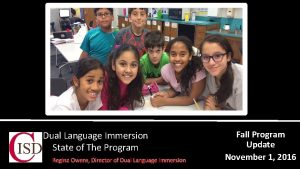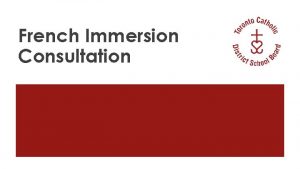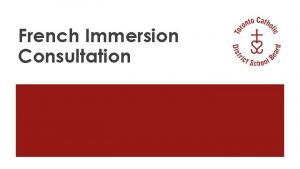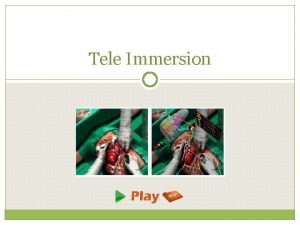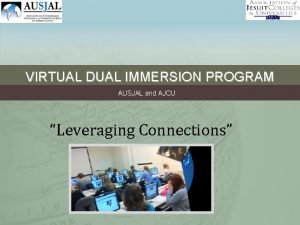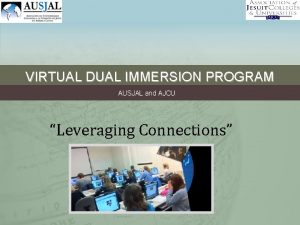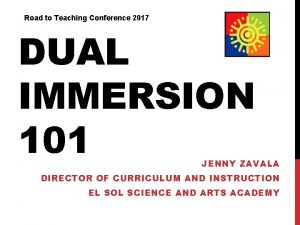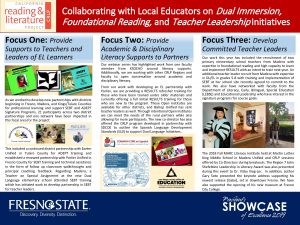1 Dual Language and Immersion Family Education E










































- Slides: 42

1

Dual Language and Immersion Family Education E CA T ED U WE PO EM R DLI Family Education ENGAGE 2 USDE Grant: Dual Language and Immersion Pathways to English Learner Success

Partners 3 USDE Grant: Dual Language and Immersion Pathways to English Learner Success

Introductions Pixabay o o o Your name Number and ages of your children Your school Languages spoken at home What motivated you to come here tonight 4

Mission Statement To enrich the educational experience of Dual Language and Immersion (DLI) learners by engaging, educating, and empowering families. 5 USDE Grant: Dual Language and Immersion Pathways to English Learner Success

Student R ENGAGE UC ED WE PO AT E EM Family Success in school and beyond Teachers & School 6 USDE Grant: Dual Language and Immersion Pathways to English Learner Success

Workshop Topics 1. 2. 3. 4. Dual Language and Immersion Basics Bilingualism and Biliteracy The Challenges of DLI College and Career Opportunities 7

Session Objective I understand the goals and key features of Dual Language and Immersion Education (DLI). 8

D Bili evelop ngu m al E enta duc l atio n age gu Lan ay sion e-w mer Im On ay o-w on Tw ersi m Im NAWHERC Ind i Imm genou ers s ion What is Dual Language and Immersion? Minnetonka Public Schools 9 Pickit (Adapted from “The Dual Language Umbrella” in U. S. Schools [Howard et al. , 2003] )

The Goals of DLI Education Openclipart Academic Achievement Bilingualism and Biliteracy Cultural Competence 10 (Fortune, 2013)

The Goals of DLI Education Openclipart Academic Achievement 11

Academic Achievement In general, by middle school, both English home language and partner home language/bilingual students do as well as or better on standardized tests given in English (Math, Reading, Language Arts) than their peers in English-only classrooms. Maxpixel 12 (Lindholm-Leary & Genesee, 2014)

Academic Achievement o English home language students may experience a temporary lag in English reading and writing skills, but within a year or two after instruction in English language arts begins, the lag disappears. Pickit (Genesee, 1987) o For Hmong heritage learners who speak English at home but whose parents are English language learners themselves, this lag may take longer to disappear. 13

14

English learners in DLI programs o catch up to their English-speaking peers in reading by Grade 5 or 6. o outperform average English-speaking peers if they continue in the program through 15 high school.

What makes the difference for Hmong ELs? o continued learning in Hmong in school o ongoing use of Hmong in the home 16

The Road to Academic Achievement pixshark o Read each “bump in the road” statement. o Share ideas you have for responding to these “bumps. ” 17

Pixabay. com o Remind your child just how special it is to be reading in language. Inanother 2 nd grade, you might begin to worry that your child isn’t oyet If your child feeling Plus, disheartened not friends being able to reading in is English. your childabout may see read a much certain book and in English, read the book aloud together reading harder more interesting books in English if that possible check out the audioexperience. book from the and mayiswant to beorpart of that reading library. o But continue to encourage reading in the partner language and show enthusiasm for the books your child can read. 18

Pixabay o Remember that it takes time for positive academic Inoutcomes 3 rd grade, towhen standardized testing begins, your appear. test scores may be lower than expected. ochild’s Your child is on the path to speaking, reading and writing in two languages, reaping many benefits along the way that are not measured on a standardized test. 19

The Goals of DLI Education Openclipart Bilingualism and Biliteracy 20 (Fortune, 2013)

The Goals of DLI Education Openclipart Cultural Competence 21 (Fortune, 2013)

Cultural Competence In a DLI program, partner language and culture are intertwined and are both highly valued. R. J. Lozada In a Hmong DLI program, students learn to understand, communicate with, and effectively interact with people both in English and in Hmong. R. J. Lozada (Australian Children’s Education and Care Quality Authority, 2014) 22

Cultural Competence Some research findings: 1. Two-way immersion students value having classmates from a variety of linguistic and cultural backgrounds. 23 (Feinauer & Howard, 2014)

Cultural Competence 2. Positive cross-cultural attitudes are frequently more common among DLI students than among students in other types of programs. 3. Partner language students say 2 things are central to their identity: • attending a two-way immersion program • the opportunities two-way immersion gives them for extended home language and literacy development. 24 Max. Pixel (Feinauer & Howard, 2014)

Cultural Competence Learning a language without the cultural framework in which it exists is like cooking ethnic food without the spices of the region. You simply will remove all of the flavor from the language. 25 (Zart, 2012)

The Road to Cultural Competence Pixsharkk o Read the “bump in the road” statement. o Share ideas you have for responding to these “bumps. ” 26

Pixabay o Research shows thatchildren all DLI children regardless home In 4 th grade, many begin to–assert their of identity language use English, and that. U. S. /Englishpreference and have–aprefer strongto desire to “fit in” with increases they advance in grades (e. g. , to Ballinger Lyster, speaking as culture. They might not want speak&Spanish 2011; Freeman, 1998; Hernández, 2015; Potowski, 2004). anymore. This is true for all learners. o It’s your job to remind your child of the value of bilingualism and to offer encouragement, praise, and support. 27

28

29

Key Features of DLI o 50% or more of partner language instruction (Hmong) through the elementary years. o High status of partner language and culture in the classroom and in the school community. o Fairly equal numbers of two groups of students are recommended: English-speakers and speakers of a partner language, such as Hmong. 30 (Christian, 2011; Fortune & Tedick, 2008; Hamayan, Genesee & Cloud, 2013)

Key Features of DLI o An integrated language and content model, which provides a wide variety of contexts in which to use the target language. 31 (Christian, 2011; Fortune & Tedick, 2008; Hamayan, Genesee & Cloud, 2013)

Key Features of DLI o Literacy instruction in both languages for all learners throughout the program. o Core subjects (math, science, social studies) divided between languages. Pickit o Integration of English-speaking and Hmongspeaking language learners for all instruction. 32 (Christian, 2011; Fortune & Tedick, 2008; Hamayan, Genesee & Cloud, 2013)

Key Features of DLI o Instruction in the same core subjects as in the other schools in the district: mathematics, language arts, science, and social studies. Pixabay o Instruction based on national and state standards and district curricula. 33 (Christian, 2011; Fortune & Tedick, 2008; Hamayan, Genesee & Cloud, 2013)

Key Features of DLI o Maximizing teacher and student use of Hmong during instructional time in Hmong. R. J. Lozada 34 (Christian, 2011; Fortune & Tedick, 2008; Hamayan, Genesee & Cloud, 2013)

Tic-Tac-Toe! What do you know? 1. Place your cards face down to form a grid, with the X/O “wild card” in the middle. 2. Turn over one card at a time and read the statement. Together, the team decides if the statement is true or false. 3. If it is true, place an O on the card. If it is false, place an X. 4. If you get 3 in a row, call out Tic-Tac-Toe! but continue filling in your grid. 35

In a two-way DLI program, all learners are partner language speakers (Hmong). 1 In a two-way DLI program, students are separated by their home language for instruction. DLI students receive instruction in the same core subjects as do English-only students. 2 In a DLI program, at least 50% of instruction is in the partner language (Hmong). 3 4 36

In the DLI classroom, language and culture are intertwined. 5 Once English begins, the majority culture (English) is dominant in the classroom. 7 Teachers use both languages during any given lesson. 6 DLI students must meet state standards. 8 37

We thank you for coming tonight! Please complete the short questionnaire to help us to see what you learned in this workshop and how we can improve it. Pixabay 38 USDE Grant: Dual Language and Immersion Pathways to English Learner Success

References Australian Children’s Education and Care Quality Authority (ACECQA). (2014). What does it mean to be culturally competent? Retrieved from https: //wehearyou. acecqa. gov. au/2014/07/10/what-does-it-mean-to-be-culturally-competent/. Center for Applied Linguistics. (2005). The two-way immersion toolkit. Retrieved from http: //www. cal. org/twi/. Center for Applied Second Language Studies. (2013). What levels of proficiency do immersion students achieve? Retrieved from https: //casls. uoregon. edu/wp-content/uploads/pdfs/tenquestions/TBQImmersion. Student. Proficiency. Revised. pdf. Christian, D. (2011). Dual language education. In E. Hinkel (Ed. ), Handbook of research in second language teaching and learning. Vol. II (pp. 3– 20). NY: Routledge. Feinauer, E. , & Howard, E. R. (2014). Attending to the third goal: Cross-cultural competence and identity development in two-way immersion programs. Journal of Immersion and Content-Based Language Education, 2(2), 257– 272. Fortune, T. W. (2013). The ABCs of dual language and immersion education. Immersion 101 Summer Institute, Center for Advanced Research on Language Acquisition. Minneapolis, MN: University of Minnesota. Fortune, T. W. , & Tedick, D. J. (2008). One-way, two-way, and indigenous immersion: A call for cross-fertilization In T. W. Fortune, & D. J. Tedick (Eds. ). Pathways to multilingualism: Evolving perspectives on immersion education. (pp. 3– 21). Clevedon, England: Multilingual Matters, Ltd. Genesee, F. (1987). Learning through two languages: Studies of immersion and bilingual education. Cambridge, MA: Newbury House. 39

References Genesee, F. (2007). Top ten most consistent findings from research on foreign language immersion. The ACIE Newsletter, 10(3), 7 & 10. Hamayan, E. , Genesee, F. , & Cloud, N. (2013). Dual language instruction from A to Z. Portsmouth, NH: Heinemann. Howard, E. R. , Olague, N. , & Rogers, D. (2003). The dual language program planner: A guide for designing and implementing dual language programs (p. 3). Washington, DC & Santa Cruz, CA: Center for Research on Education, Diversity & Excellence. Lindholm-Leary, K. J. , & Genesee, F. (2014). Student outcomes in one-way, two-way, and indigenous language immersion education. Journal of Immersion and Content-Based Language Education, 2(2), 165– 180. Thomas, W. P. , & Collier, V. P. (2012). Dual language education for a transformed world. Albuquerque, NM: Dual Language Education of New Mexico and Fuente Press. Zart, B. (2012). The importance of culture in language learning. Retrieved from https: //billzart. wordpress. com/2012/03/04/theimportance-of-culture-in-language-learning/. 40

Acknowledgements and Permissions Clipart taken from Creative Commons, Pickit, Pixabay, Max. Pixel, and Pixshark are copyright-free and do not require permission or attributions. The following images are reproduced with permission from their respective sources: Slide 9: one-way immersion: Minnetonka Public Schools, Minnetonka, Minnesota (https: //www. minnetonkaschools. org) Slide 9: indigenous language immersion: The Native American Women’s Health Education Resource Center (https: //www. nativeshop. org/) Slides 14, 15, and 16, graph: Wayne P. Thomas and Virginia P. Collier (https: //www. thomasandcollier. com) Slides 22 & 34, R. J. Lozada (https: //vimeo. com/55717676) 41

Authors University of Minnesota: • Maureen Curran-Dorsano Diane J. Tedick • Corinne Mathieu • Special thanks to our translators, • Bounthavy Kiatoukaysy • See Pha Vang • May Lee Xiong • Phoua Yang and to our external consultant, Edward M. Olivos, University of Oregon Contributors • • • • Amanda Lea (Eastern Carver County) Cathy Camarena (St. Paul) Teresa Chavez (Roseville) Carolina Du. Fault (Risen Christ) Tara W. Fortune (UMN) Leticia Guadarrama (Minneapolis) Liz Hathaway-Castelán (St. Paul) Laura Hofer (Richfield) Bounthavy Kiatoukaysy (St. Paul) Corina Pastrana (Minneapolis) Melissa Richards de Campaña (St. Paul) Anita Sasse (Northfield) 42 Kate Trexel (UMN) Megan Unger (Minneapolis)
 Pros and cons of dual language programs
Pros and cons of dual language programs Guiding principles for dual language education
Guiding principles for dual language education Zeon
Zeon Dual career family definition
Dual career family definition Senarai sekolah menengah dlp selangor
Senarai sekolah menengah dlp selangor Difference between nuclear family and joint family
Difference between nuclear family and joint family Ponding and immersion
Ponding and immersion Family education rights and privacy act
Family education rights and privacy act Family economics and financial education
Family economics and financial education Fefe lesson plans
Fefe lesson plans Hfle curriculum trinidad secondary
Hfle curriculum trinidad secondary Family economics and financial education
Family economics and financial education Difference between education and literacy
Difference between education and literacy Differences between health education and physical education
Differences between health education and physical education Carbon family
Carbon family Binuclear family vs blended family
Binuclear family vs blended family Introduction of work immersion
Introduction of work immersion Objectives of work immersion
Objectives of work immersion Late french immersion halifax
Late french immersion halifax Immersion tube coating pan
Immersion tube coating pan Oil immersion cooling
Oil immersion cooling Structured english immersion model
Structured english immersion model Cold shock
Cold shock Immersion sword system
Immersion sword system What is an exposure incident milady
What is an exposure incident milady Immersion vs sprinkling baptism
Immersion vs sprinkling baptism Immersion vs sprinkling baptism
Immersion vs sprinkling baptism Immersion interaction imagination
Immersion interaction imagination French immersion halifax
French immersion halifax Ateneo immersion scandal
Ateneo immersion scandal Work immersion checklist
Work immersion checklist Dip wrap method paraffin
Dip wrap method paraffin Humble isd spanish immersion
Humble isd spanish immersion Immersion teaching
Immersion teaching Tandem technique in ultrasonic testing
Tandem technique in ultrasonic testing Immersion lithography
Immersion lithography Dut gtr
Dut gtr Immersion probe for soup
Immersion probe for soup Immersion marketing
Immersion marketing Montana 529 plan
Montana 529 plan What is adc
What is adc Double bar grouser worksheet
Double bar grouser worksheet Combinational logic analysis
Combinational logic analysis




